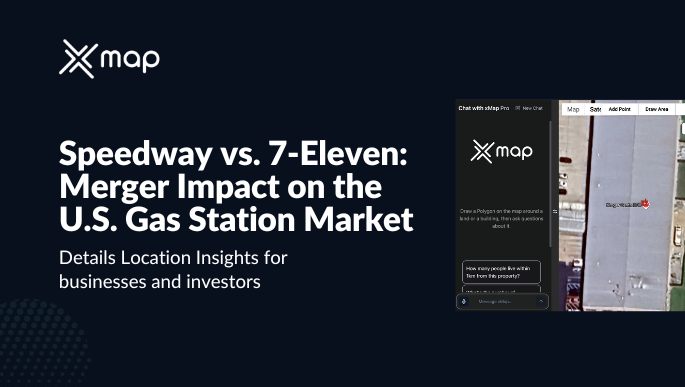Speedway vs. 7-Eleven: Merger Impact on the U.S. Gas Station Market in 2025

- Remove the current class from the content27_link item as Webflows native current state will automatically be applied.
- To add interactions which automatically expand and collapse sections in the table of contents, select the content27_h-trigger element, add an element trigger, and select Mouse click (tap).
- For the 1st click, select the custom animation Content 27 table of contents [Expand], and for the 2nd click, select the custom animation Content 27 table of contents [Collapse].
- In the Trigger Settings, deselect all checkboxes other than Desktop and above. This disables the interaction on tablet and below to prevent bugs when scrolling.
The U.S. gas station and convenience store market has always been competitive, but few deals have reshaped it as profoundly as 7-Eleven’s $21 billion acquisition of Speedway in 2021. Now, four years later in 2025, the ripple effects of this historic merger are fully visible. From market share dominance to consumer pricing, loyalty programs, and competition with other giants like Circle K and Casey’s, the combined entity has transformed the fueling and convenience landscape.
In this article, we’ll dive into updated 2025 data on store counts, geographic reach, market share, customer experience, and what this merger means for the future of U.S. gas stations.
The Scale of the Merger
Before the acquisition, Speedway was a major Midwest powerhouse, with about 3,800 stores. 7-Eleven already operated the largest convenience store network in the U.S. The deal combined these footprints into a retail behemoth.
By 2025, 7-Eleven (including Speedway locations) has ~13,500 stores across the United States, making it by far the largest convenience store chain in the country. This scale gives it leverage in fuel procurement, retail pricing, and supply chain efficiency that few competitors can match.
Here’s a breakdown of store counts for 2025:
Geographic Footprint Post-Merger
One of the biggest benefits of acquiring Speedway was regional coverage. Speedway had a stronghold in the Midwest and East, while 7-Eleven was stronger in urban centers and the South/West. Together, they now blanket the country with unmatched density.
Distribution of 7-Eleven/Speedway Stores by Region (2025):
This national density allows 7-Eleven to capture not just daily commuter traffic but also long-haul travel across interstates where Speedway stations were historically strong.
Market Share and Fuel Volume
As of 2025, the combined entity holds about 8.5% of U.S. gas station market share by store count, and nearly 12% by fuel volume sold. That’s a substantial leap compared to pre-merger numbers.
Fuel volumes surged because Speedway locations tend to be larger and more focused on fuel sales compared to smaller urban 7-Eleven sites.
Here’s how the major players compare:
Consumer Impact: Pricing & Loyalty Programs
One of the biggest concerns around consolidation is how it impacts consumers. Since the merger, research shows that:
- Fuel Pricing: On average, 7-Eleven/Speedway prices are 1–3 cents higher per gallon than regional independents but still competitive with other national chains.
- Loyalty Programs: 7Rewards has been integrated into Speedway’s Speedy Rewards program, creating one of the largest loyalty ecosystems in the industry. As of 2025, more than 50 million active members participate.
- Food & Beverage: Speedway’s robust hot food program has been gradually aligned with 7-Eleven’s fresh-food strategy, offering pizza, bakery items, and healthier grab-and-go choices.
Competitive Landscape in 2025
The deal forced competitors to respond:
- Circle K doubled down on EV charger installations, with over 4,000 chargers deployed nationwide in 2025.
- Casey’s leaned into prepared food, with pizza sales now making up 25% of in-store revenue.
- QuikTrip has expanded beyond the Midwest into new Southern states, trying to build density against 7-Eleven.
Meanwhile, regulators continue to scrutinize the long-term impacts of the merger. While divestitures were required in certain markets to maintain competition, 7-Eleven still emerged with overwhelming dominance.
The EV Transition: 7-Eleven’s Strategy
Another major consequence of the merger is how it positions 7-Eleven in the EV era. In 2023, the company announced its “7Charge” network. By mid-2025, there are already 1,200 EV chargers installed at U.S. stores, making it one of the largest non-utility charging networks.
This aligns with consumer demand and sets the company up for resilience as gasoline demand gradually plateaus.
Future Outlook
The Speedway–7-Eleven merger is a textbook case of how scale reshapes industries. In the near future, we expect:
- More Partnerships: Integration with delivery services and quick-commerce apps will expand.
- Enhanced Food Programs: Speedway’s hot food heritage will merge with 7-Eleven’s global food R&D.
- EV Expansion: Expect 7Charge to exceed 5,000 chargers by 2030.
- Price Competition: Independent operators will continue leveraging lower local overhead to compete on fuel pricing.
Conclusion
In 2025, the Speedway–7-Eleven merger stands as one of the most consequential deals in U.S. gas station history. It created a retail juggernaut with unmatched national density, strong pricing power, and a loyalty ecosystem that millions of consumers now depend on.
For drivers, this means more consistent experiences across the map, slightly higher average fuel prices, and greater convenience. For competitors, it’s a wake-up call to innovate, expand, and find their own edge in a market increasingly defined by consolidation and technological transition.
連絡を取る
あなたの目標やプロジェクトの規模が何であれ、私たちはそれを処理します。
100% ご満足いただけるよう努めます。
「私たちは、中東のビジネスニーズに合わせた質の高いデータを提供することに重点を置いています。レストラン、ホテル、ジムのいずれであっても、地理データを使用して業務上の意思決定を強化できます。」





